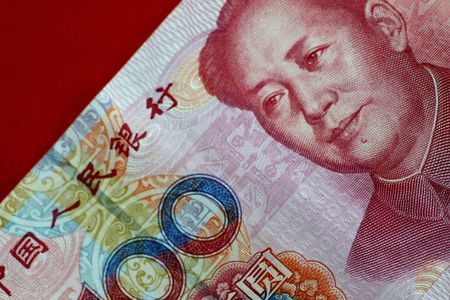SHANGHAI/HONG KONG (Reuters) -The launch of the world’s first regulated offshore yuan-linked stablecoin in Kazakhstan this month is part of Beijing’s plan to use the blockchain technology for cross-border trade, an executive at a Chinese government-backed blockchain network said.
Yang Guang, Shanghai-based chief technology officer of Conflux, which was involved in the launch, said that although the event was low-key it could have a “butterfly effect” with potential to reshape cross-border payment.
AxCNH, a cryptocurrency pegged to the offshore Chinese yuan, was launched on September 17 by Hong Kong-based fintech firm AnchorX, underpinned by Conflux’s technology, after obtaining a licence in Kazakhstan, Central Asia’s biggest economy.
The move indicates China’s intention to chip away at the dollar’s dominance in the crypto space, and reflects the multi-pronged push for yuan internationalisation, which also includes promoting the central bank digital yuan.
China was considering allowing the usage of yuan-backed stablecoins, a type of cryptocurrency designed to maintain a constant value, for the first time to boost wider adoption of the yuan globally, Reuters reported last month.
China has long aspired for the yuan to achieve global currency status, reflecting its weight as the world’s No.2 economy. However, its tight capital controls and its trillion-dollar annual trade surpluses have worked against that aim.
“As U.S. dollar stablecoins grow, can you imagine a digital world in 10, 20 years’ time, where there’s no place for the Chinese yuan on blockchains? Of course not,” Yang, a computer scientist from Tsinghua University, told Reuters.
Yang said issuing offshore yuan stablecoins did not theoretically need approval from China’s central bank, and Beijing would be supportive of such a move if it was used to lubricate cross-border trade.
“As a major power, China cannot miss any potentially promising technology and will invest in every direction, including blockchain,” he said.
‘POSITIVE VIEW’
A stablecoin is a type of cryptocurrency typically pegged to a fiat currency such as the U.S. dollar. It is seen as a low-cost, efficient cross-border payment tool, as well as a bridge linking traditional finance and digital assets.
China is ramping up efforts to promote global use of the yuan, as U.S. President Donald Trump’s tariff war and capricious policies re-route global trade flows and dent trust in the greenback.
Conflux has a government mandate to build a blockchain platform linking countries in the Belt and Road Initiative (BRI), China’s flagship international cooperation strategy, Yang said.
Hong Kong, which has established a regulatory regime for stablecoins, has not yet awarded any licences to issuers. In China, cryptocurrency trading has been banned since 2021.
AnchorX said on its website that the newly launched yuan stablecoin was a cost-effective and efficient payment alternative to traditional finance, and would enhance cross-border transactions between BRI countries and offshore China entities.
The company, backed by Conflux and Chinese investment firm Hony Capital, said it issued the stablecoin after obtaining a licence from financial regulators in Kazakhstan, a BRI participant which counts China as its biggest trading partner.
For China, “the stablecoin initiative serves as another venue or trial to push the use of the offshore yuan,” said Augustine Fan, head of insights at SignalPlus, a digital asset trading platform.
It also shows the “government is likely to maintain a positive view towards the underlying potential of blockchain technology,” Fan said, adding that regulators will take a measured and cautious approach.
(Reporting by Shanghai Newsroom; Editing by Sumeet Chatterjee and Stephen Coates)









